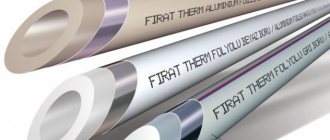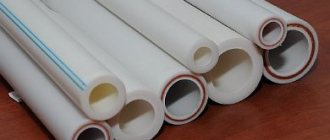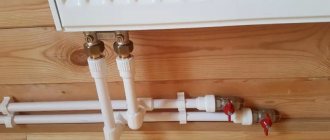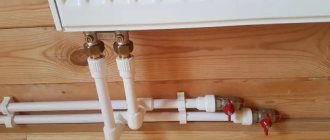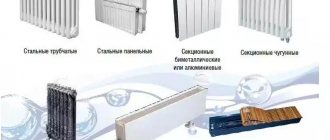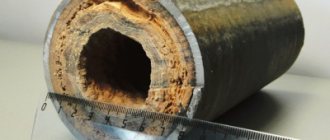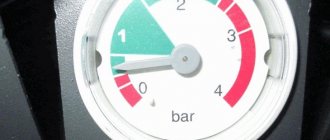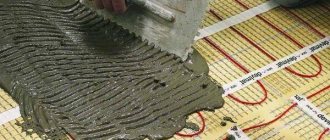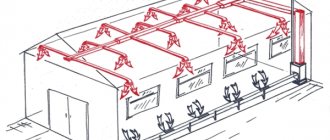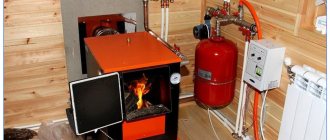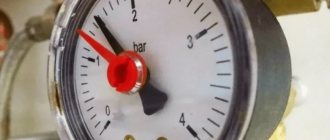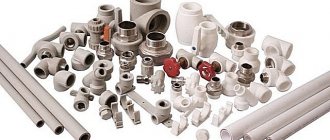Today, increasingly, plumbing and heating systems are made not from steel pipes, but from polypropylene. But this is plastic, and the question arises - what is the maximum temperature that a polypropylene pipe can withstand?
Let's look at this issue in more detail. Let's consider the properties of polypropylene material. Let's get acquainted with the types of polypropylene pipes and their characteristics. We’ll also talk about the temperatures that this pipeline can withstand, and the features of its use in hot water supply lines.
Properties of polypropylene
Polypropylene is a synthetic polymer product in the form of a white powder; a profile is made from it by melting or pressing. This is the hardest and most resistant type of plastic, not subject to corrosion.
The main physical properties of polypropylene are durability, reliability, wear resistance, and resistance to high temperatures. It is not susceptible to the action of chemicals, salts and alkaline solutions, so these substances in water are not dangerous for this pipeline.
Polypropylene products:
- weigh less than steel;
- do not emit substances harmful to health - suitable for installation in domestic premises;
- the inner surface is smooth, which does not allow scale deposits;
- the level of thermal conductivity is low;
- good sound insulation;
- high electrical insulation;
- heat capacity index 2.0 kJ/(kg.°C);
- permissible temperature level -15 - +120;
- density value – 0.92 kg/cm³.
Polypropylene softens at +140 degrees, and the melting point is +175 - this is the temperature of steam.
This factor makes a polypropylene pipeline suitable for cold or hot water supply (especially reinforced ones) , where the temperature of the coolant is kept at +95, but it cannot be used as a steam pipe.
When heated, polypropylene becomes soft, and after cooling, all its physical properties return to it, and it becomes hard again, so assembling a water main from these products is appropriate, and the process of connecting pipeline elements is quite simple. It is enough to heat its ends and join them; it is also possible to connect them with couplings.
The main disadvantage of polypropylene is its plasticity. When heated, the product softens and can be easily bent. But when such a profile is bent, the internal diameter decreases significantly and the throughput level decreases.
In addition, this material is afraid of light; the product may lose its shine, crack, or fade. To avoid this, various components are added to polypropylene.
It is worth noting that polypropylene does not tolerate frost well; it becomes brittle at temperatures ranging from minus 5 to 15 degrees. This material deficiency can also be eliminated by adding ethylene or ethylpropylene rubber.
The standard pressure indicator for polypropylene products is 30 kg per 1 cm2. But according to manufacturers’ recommendations, it should not exceed 10 kg.
Blitz tips
When using pipes made of various materials, you need to know some of their features:
- Copper pipe can be welded using low-temperature and high-temperature methods, which is more reliable. But when exposed to high temperatures, copper darkens and loses its attractiveness. So you need to be prepared to mask the seam;
- The copper weld area is stronger than the rest of the surface. Therefore, it can burst anywhere, just not at the seam;
- When installing metal-plastic products, it is better to use a fitting with a press sleeve, then the connection point will never bother you. Otherwise, the nut will have to be tightened from time to time;
- Even a beginner can weld polypropylene, but heating below normal will lead to leakage, and overheating will narrow the gap. The repairability of the material is zero, so it is better to entrust the installation of the system to a professional.
Types of polypropylene pipes
Polypropylene pipes are divided into two main types: reinforced or unreinforced . They are also divided according to their layout and material of manufacture. If the product has a blue stripe, then it is recommended for cold water supply, and a red one for hot water supply.
Products made of polypropylene of any type are marked with the letters PN. The number next to the abbreviation PN affects the cost, and accordingly, the larger it is, the higher the price.
Polypropylene and Heating? It makes sense?
unreinforced
The purpose of non-reinforced types is cold water lines. They are not suitable for hot water supply, since when heated, the pipeline can lengthen - every 10 meters by 150 mm, which will cause it to rupture. Although, in low-temperature structures, installation of unreinforced models is possible, but only if the pressure is not high.
Such types have increased flexibility, ductility and low cost. Conventional profiles are easy to install, since the connection areas with the fitting are free of obstacles.
The following markings are placed on polypropylene products, which indicate the permissible maximum temperature:
- PN 10 - permissible temperature + 45 (for floor heating) and + 20 (for water supply), pressure 1 MPa. Wall thickness - 10 mm, diameter - from 20 to 110 mm.
- PN 16 - permitted pressure 1.6 MPa, temperature value + 60. Wall thickness from 3.4 mm.
- PN 20 - permissible pressure of 2 MPa, at a temperature of + 80 degrees. Wall thickness 16 - 18.4 mm.
The service life of unreinforced mains when used in cold water supply reaches 50 years, 30 years if heated coolant moves through them.
Reinforced
Reinforcement - the presence of an additional aluminum or fiberglass layer. This material makes the product stronger, increases its service life, even in the presence of hot coolant, the profile will last up to 50 years.
In addition, reinforcement allows the use of this pipeline with water heated to + 120 degrees, without the risk that linear expansion will occur, with further rupture of the line.
The purpose of models with reinforcement is hot water supply with high pressure. This type:
- more resistant to chemicals;
- its expansion coefficient is 5 times lower than the usual profile;
- ability to withstand high temperatures and maximum loads.
According to the reinforcement material, profiles are:
- With an aluminum layer - these models have a high operating pressure level, so they are suitable for central heating and hot water. The aluminum layer reduces the degree of thermal deformation and oxygen diffusion.
Installation of an aluminum-reinforced profile is difficult, since contact of the aluminum layer with water is not allowed. Therefore, the joints must be cleared of a few centimeters of the reinforcing coating.
- Fiberglass reinforced - have a low level of expansion. Fiberglass fiber reduces deformation when heated. Compared to aluminum models, such products have a lower heating pressure, so they are less in demand.
The installation process of this type is simpler, because no stripping is required. Fiber fibers are connected to each other with molten polyethylene, and there is no delamination of the material.
- Pipes reinforced with basalt fiber. This type has a lot of advantages, compared not only with any reinforced models, but also with profiles made of plastic and metal. It is easier to install compared to aluminum coating, since there is no need to strip it. Basalt products are easily connected to any types of polypropylene fittings.
Reinforced pipes are marked PN 20 and PN 25. They are able to withstand temperatures of + 95 and pressures of up to 2.5 MPa.
But not all reinforced products are able to withstand higher degrees of heating. For example, aluminum ones cannot withstand the temperature that a fiberglass-reinforced polypropylene pipe can withstand - + 120 (although also not for a long time).
Marking
In addition to the PN marking, which indicates temperature and pressure, all plastic pipes have:
- the word "pipe";
- abbreviated name of the material;
- SDR - the value of the ratio of the external size to the thickness of the walls;
- external profile size;
- operational class;
- working pressure limit;
- Standart room.
For example:
Pipe PP-R SDR 11-20´ 1.9 class 1/1.0 MPa GOST R 52134-2003, where:
- random polypropylene profile - SDR 11 copolymer;
- outer diameter 20 mm;
- wall thickness 1.9;
- class 1;
- permissible pressure 1 MPa.
According to their structure, profiles are divided into:
- S - single-layer;
- M - multilayer;
- TI - with a thermal insulation layer;
- PP - standard;
- PP-RP - high pressure resistant.
By type of material there are:
- PPB - they have high strength, their purpose is floor heating with hot coolant;
- PPH - have an increased internal diameter, mounted on ventilation systems and cold water;
- PPR is a universal type that can withstand elevated temperatures.
By class they are divided into:
- class 1 - up to +60 C, intended for water supply;
- 2 - up to +70 (pipelines);
- 3 - + 60 (warm floors);
- 4 - +70 C, used for heating;
- 5 - + 90 (heating);
- class XB - for cold water supply.
Some manufacturers put a trademark on their products.
Temperature table
For clarity, we have presented a table of temperatures that polypropylene pipes can withstand.
| View | Purpose | Maximum temperature level | Working pressure (atm) |
| PN 10 | Cold water supply | +40 C | 10,2 |
| PN 16 | Universal model | +60 | 16,3 |
| PN 20 | Universal | +80 — 95 | 20,4 |
| PN 25 | Hot water | +95 — 120 | 25,5 |
Features of use in a heating system
Destruction temperature of polypropylene pipes.
Today, polypropylene profiles are increasingly installed both in central heating systems and are used to heat private buildings. They do not deform, do not allow oxygen to pass through, are able to withstand sub-zero temperatures and, as a result, freezing of water in the main does not cause damage to the system as a whole.
To the question of which polypropylene pipe for heating is best to purchase, you can give a clear answer - you need to take a pipe that can withstand a maximum temperature of +60 - +95 C. The most suitable models are PN 20 with a heating degree of +60 or PN 25 - +95.
When choosing polypropylene profiles for heating, in addition to temperature, you should consider that:
- Plastic products are rigid and difficult to bend. To turn the highway, you need to install an angle, which is not very convenient.
- The cross-section of the pipes must correspond to the size of the risers to which they will be connected. In a private house, the central wiring is made from a profile with a cross-section of 32 mm, the connection to the batteries is made with pipes measuring 20 - 25 mm.
- PP pipe fittings have a large cross-section, which worsens the appearance of the system.
- Polypropylene stretches when heated, this leads to thinning of the walls and sagging of the pipeline, which looks unsightly when installed openly.
When installing a plastic pipeline, it is important not to overheat it, as this will lead to a decrease in the passage when inserting it into the fitting. This error significantly reduces the efficiency of the system.
In addition, polypropylene products are not recommended for piping boilers. In the boiler room there is a frequent change in temperature, which is contraindicated for this profile.
If you take into account all the above points, then polypropylene types with a maximum temperature of +95 are quite suitable for heating.
Installation features
Products made from chlorinated polyvinyl chloride cannot be joined by soldering. They are connected with a special high-molecular glue. The method is in many ways similar to cold soldering, since the liquid composition is made from a mixture of polyvinyl chloride and a solvent. Since it takes several minutes to polymerize, joining in hard-to-reach areas becomes more difficult due to problems with ensuring immobility during this time.
Installation of PVC pipes for heating is so simple that it can be carried out by one person who does not have special skills. Due to the low thermal expansion, laying can be done without expansion joints, since the communication is not subject to significant loads. Therefore, sliding fastenings are quite sufficient. Low thermal conductivity allows you to install risers inside external walls without additional protection from the cold. The connection to metal pipes and radiators is made using special fittings - nurses and American ones or loose flanges.
Installation is carried out in the following sequence:
- The branching of the heating system is assessed.
- The most complex knees are assembled.
- The remaining connections are installed at the installation site.
Application of polypropylene pipes in hot water supply
When installing a hot water line, you must remember that polypropylene pipes have a high expansion coefficient when heated. If the heating level of the coolant increases by 10 degrees, then the polypropylene pipeline increases by 1.25 mm per meter. When using reinforced - 0.32 mm/m.
The heating temperature of the coolant supplied to individual consumers ranges from + 45 to 75 degrees. Based on this, in order to ensure uninterrupted supply of such systems, it is recommended to install reinforced polypropylene pipes of grade PN 20 or 25, with a pressure of 2 to 2.5 MPa.
Polypropylene, a common material in the production of water pipes. With the right model, and if you follow all the recommendations for using polyethylene pipes, they will serve you for decades.
Testing polypropylene ch1
We calculate the return for 1 m of product
Q = 0.047*10*60 = 28 W.
- K = 0.047, heat transfer coefficient;
- F = 10 m2, pipe area;
- dT = 60° C, temperature difference.
It's worth remembering
Do you want to make a heating system correctly? You should not select pipes by eye. Heat transfer calculations will help optimize construction costs. In this case, you can get a good heating system that will last for many years.
Today the issue of energy saving is very acute. This applies to literally every user. Therefore, when designing heating systems in private construction on their own, zealous owners immediately think about heating systems and their efficiency.
It is more difficult for those who operate previously created heating systems, since they are faced with the question of increasing the share of heat transfer in already completed objects.
